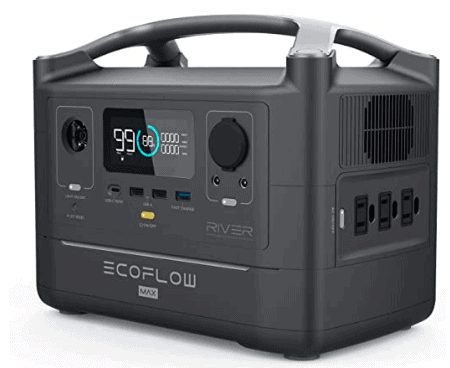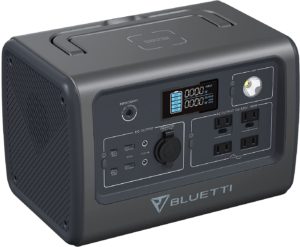WARNING: Jackery Explorer 500 Review + Top 2 Alternatives

Written by qualified solar engineer Carlos. Last updated:
Table of Contents
Having a backup source of power is valuable whenever the grid is down, but it’s also very important if you want to have an incredible experience outdoors, whether that is a week-long camping trip or a long picnic day with family and friends.
In this review, we cover one of the best and most reliable options available for backup power, the Jackery Explorer 500. We will also check out two valuable alternatives that you can consider to make the best possible choice among solar generator products. Let’s jump to it!
What is the Jackery Explorer 500?
The Jackery Explorer 500 is a portable power station manufactured by Jackery, one of the top brands in the backup market, integrated with an array of cylindrical 2400 lithium-ion battery cells with a high energy density capable of storing up to 518Wh of energy ([email protected]). This valuable device has a rated power capacity of 500W and 1000W for a surge.
This power station features multiple ports, including:
Jackery Explorer 500 Outlets:
| 3 x | USB – A ports |
| 2 x | 12V DC ports |
| 1 x | 12V car outlet |
| 1 x | 110V AC outlet – pure sine wave output at 60Hz |
Moreover, some of the extra features that the Jackery Explorer 500 comes with are:
- Built-in LED flashlight
- Built-in MPPT charge controller
- Carry on solid handle
- Built-in LED display
- Car charger cable
- AC charging cable
What can I power with the Jackery Explorer 500?
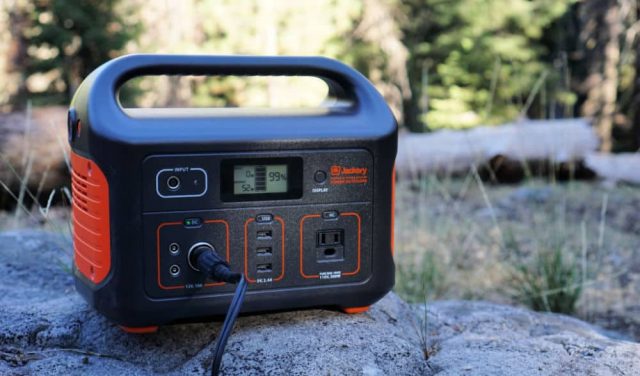
The Explorer 500 is capable of powering multiple appliances and electronic devices, including any of the following:
- Blenders (300W)
- CPAP machines
- TVs
- LED Lights
- Electronics: Smartphones, cameras, drones, iPads, headphones, etc.
- Electric blankets (40W)
- Heated travel mugs (100W)
- Mini-cooler
You will notice that all of these devices have a power consumption below 500W. Keep in mind that the AC output port is rated for a maximum continuous capacity of 500W, and exceeding this amount will cause the Explorer 500 to shut down automatically as a safety measure.
Any appliance powered with AC will need to have a demand below 500W to be connected to the Jackery Explorer 500. In other words, you cannot power appliances like toasters, kettles, or electric frying pans with this portable solar generator. To make sure you can connect a device, check the power rating specs of whatever it is you want to power.
That said, the Jackery has a surge power rating of 1000W, which means it can provide an extra burst of power for a few seconds to get the appliance started, typically useful for appliances with small motors. This feature could come in handy for some small and low-demand fridges, but you would need to make sure that the continuous demand from the DC motor is below 500W.
How Can the Jackery Explorer 500 be charged?
You can fully charge this power station in several ways:
| Car charger | 7.5 hours |
| AC wall outlet | 7.5 hours |
| Solar panels | 9-10 hours |
Keep in mind that the input terminal for all charging sources is rated to be below 100W. For solar panels, Jackery also offers the optional Solar Saga 100W solar kit that you can connect to the Jackery 500. As you can see above, using solar panels would take around 10 hours to charge the Explorer 500 fully; however, this can increase if weather conditions are not favorable.
What Do We Like About The Jackery Explorer 500?
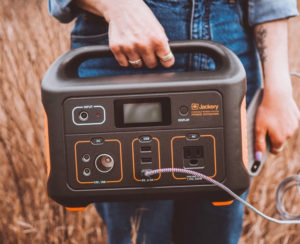
- Warranty period by Jackery is over 24 months.
- Heavy duty built-in battery management system: Designed for under and over-voltage protection, short circuit, and overcurrent protection, and over-temperature protection while charging or discharging.
- Built-in MPPT charge controller: Best technology for tracking the maximum power point of solar power generation is built-in the power station.
- Over 500 Lifetime cycles: Jackery guarantees the Explorer 500 can last over 500 charging and discharging cycles with over 80% of its nominal capacity.
- Portability: The weight and dimensions of the Jackery make it perfect for outdoor and camping experiences as you can easily move it from one place to the other.
- Multiple input and output options. The Explorer 500 is capable of charging multiple devices at the same time, including AC and DC appliances. Plus, you can simultaneously charge it in one of the three ways we mentioned before.
- Built-in Flashlight: A useful extra feature that the Explorer 500 has is that it integrates an LED flashlight that, despite not being the brightest light available, can run for hours and hours with minimum impact in the battery capacity.
- Great temperature performance: Another notable feature is that the Explorer 500 can be charged, used, and stored in any location that has an ambient temperature from 0 to 40°C (32-104°F). It is suitable for locations with high temperatures, which is important for summer camping.
What We Don’t Like About the Explorer 500
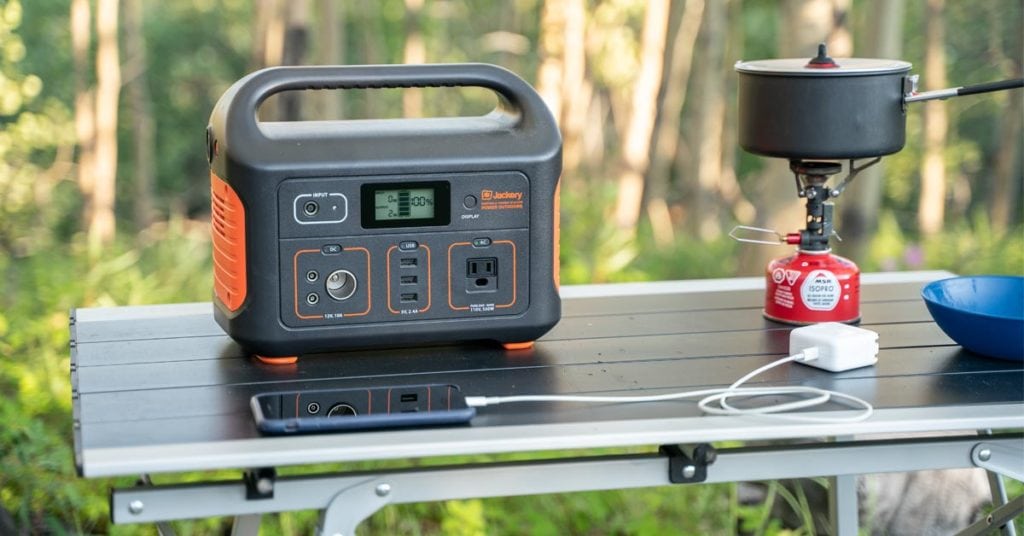
- Not waterproof: While most power stations are not waterproof, it is something to keep in mind, especially if you camp outside a lot. In this case, you would need to keep it inside the car or tent whenever it is raining.
- No way to deactivate power-saving mode: After a couple of hours, if any device connected to the Jackery 500 is not demanding power, the Explorer 500 will automatically shut down. This could be an issue if, for instance, you connect a small cooler fridge to the Jackery 500 on a cold night (when the fridge can relatively maintain its internal temperature and not require to draw much power) and leave in the morning to do some exploring in the wild. You would expect that your food would be perfectly cooled when getting back. However, you might return to find out that the Jackery shut off power to the fridge since it shut down at some point during the night to save power.
- The maximum input power is 100W: You'll probably want to have the Jackery Explorer 500 powered by solar panels; however, you may not want to wait up to 10 hours to get it fully charged with a 100W solar kit. So, you might think using a 200W solar kit will shorten the time it takes to charge the Jackery, which makes sense. But the maximum input of the Jackery is only 100W, which means you're limited to what you can use, and there is no way to shorten the amount of time it takes to charge with solar power.
What are the Best Alternatives to the Jackery Explorer 500?
If you feel the Jackery Explorer is not for you, then we have some of the best alternatives you can think of for this power station. Similar in specs, quality, and price! Let’s take a look.
The EcoFlow River 600 Max is one of the best alternatives for the Explorer 500, and here is why.
Power Rating and Connectivity
The River 600 Max has a power rating of 600W and a surge power of 1200W. You will also enjoy 576Wh of battery capacity, and what’s more important, you can use it to power up to 10 devices at once.
As amazing as it sounds, the EcoFlow River 600 has an X-Boost mode that allows it to power up to 1800W in total (although the recommendation is to stay below 1200W to maximize the energy performance use). This is possible thanks to the three 600 WAC outlets, which offer much better connectivity options than the Jackery 500.
Super-Fast Charging
What’s even more incredible about the EcoFlow 600 is its super-fast charging capability, thanks to the X-Stream Fast Charging feature, which allows it to get fully charged in less than 100 minutes using an AC wall outlet.
When using a car port, it takes just three hours to charge fully. On the other hand, if you want to use solar charging, you can connect up to two 110W solar panels for a total of 220W, which allows you to charge the EcoFlow River 600 in just around three to six hours! This time is considerably less than with the Jackery.
UPS capability
A great plus of the EcoFlow River 600 is that you can use it as a UPS device. If you have the River 600 connected to the wall outlet and have a desktop computer connected to it, the River 600 will charge the desktop using energy from the grid. However, if the grid fails, this power station will automatically switch to a battery supply mode in less than 30 seconds, actively acting as a UPS device.
Go Lightweight
Another interesting feature of the EcoFlow River 600 Max is the possibility to remove the integrated extra battery pack to reduce the weight of the power station and make it more of an on-the-go kind of device, reducing 2.5kg from the total 7.7kg that the River 600 weighs.
This design is perfect if you want a larger power station for your campsite but still want to be able to carry a smaller power station to an area nearby without having to haul the whole weight of the entire unit.
Power Ratings
Another great alternative to the Explorer 500 is the Bluetti EB70. This power station is more powerful than the Jackery model, featuring up to a 700W continuous output rating with a massive 716Wh energy storage capacity made out of a lithium-iron-phosphate (LiFePO4) battery, which is already powerful enough to run air pumps and mini-fridges comfortably.
Connectivity
Moreover, the connectivity is impressive, with up to four pure sine wave AC outlets at 110V, two USB type-C PD, and two USB-A ports. Plus, two DC output ports, a car port, and even a wireless charger of 15W for smartphones and other electronic devices with such capability.
Charging times
As for charging times, the Bluetti EB70 does not stay behind at all and even when having almost half more energy storage capacity than the Jackery Explorer 500. If you use a wall outlet, it only takes up to 4.5 hours to fully charge it. On the other hand, if you use a car port, it would take about 7.5 hours, just like the Explorer 500. Finally, if your choice is to use solar, you can expect it to be charged in less than six hours, assuming good weather conditions.
Lifetime Expectancy
One extremely valuable thing about the Bluetti EB70 when compared to the Jackery Explorer 500 is the number of cycles that the power station can run is up to 2500 at 80% capacity. This difference is huge.
Comparison: Jackery Explorer 500 vs EcoFlow River 600 Max vs Bluetti EB70
To summarize the differences between the Jackery and our best alternatives, we have pulled up this table that will help you easily see the different specs between these products.
| Jackery Explorer 500 | EcoFlow River 600 Max | Bluetti EB70 | |
|---|---|---|---|
| Power Rating (W) | 500 | 600 (expandable to 1800W with X-Boost mode) | 700 |
| Surge Power Rating (W) | 1000 | 1200 | – |
| Battery Type | Lithium-ion | Lithium-ion | Lithium-iron phosphate |
| Energy Storage Capacity (Wh) | 518 | 576 | 716 |
| Expected Number of Lifecycles | 500 to 80% capacity | 500 to 80% capacity | 2500 to 80% capacity |
| Charging times | |||
| Wall Outlet | 7.5h | 1.6 h | 4.5 h |
| Car Port (Wh) | 7.5h | 6.5 h | 7.5 h |
| Solar | 9-10h (100W max) | 3-6h (2x110W max) | 5.5h (200W max) |
| Operating Temperature range | 0 – 40°C | 0 – 45°C | -20 to 40°C |
| Number of AC Outlets | 1 | 3 | 4 |
| Number of USB Ports | 3 – USB-A ports | 2-USB A ports 1 USB-A Fast Charge port 1 USB-C port | 2-USB-A Ports 2-USB-C PD ports |
| Weight | 13.32lbs (6.04kg) | 17 lbs (7.7 kg) | 21.4lbs (9.7kg) |
| Warranty Period | 24 months | 24 months | 24 months |
Outstanding Feature (Feature that the other two do not have) | None | UPS capability Detach portable mode X-Boost mode | Wireless charging |
| Estimated Price | $500 | $550 | $600 |
Final Words
As you can see from the table above, both the EcoFlow 600 Max and the Bluetti EB70 offer far better technical specs and features than what the Jackery Explorer 500 does for a little extra money, making them the best alternatives to consider at this price range.
We hope you liked this article. Please rate it or leave us a comment.
Average rating 3.9 / 5. Vote count: 8
No votes so far! Be the first to rate this post.

